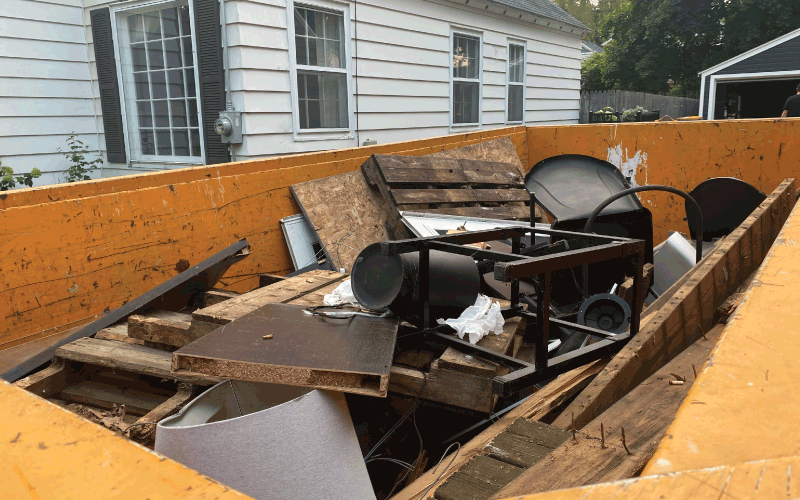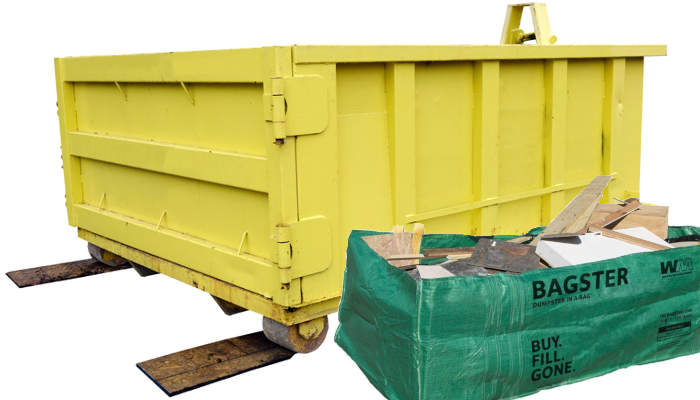
Updated April 10, 2023
Spring cleaning doesn't just include your home and garage. Once the snow melts and plants start to grow back, it's time to give your yard a thorough cleanup to get you prepped and ready for the upcoming season.
Cleaning up your yard and getting it ready for continued maintenance throughout the spring and summer season is a great way to boost your home's curb appeal and get fresh air and exercise while you're at it.
Learn where to start and how to make your yard cleanup as efficient as possible in this quick guide.
We'll go over:
- Remove Seasonal Decor, Furniture, and Other Junk
- Pick Up Refuse and Rake
- Apply Fertilizer and Weed Killer
- Prune and Trim
- Mulch
- Power Wash
- Light Demolition
Find yard waste removal in my area

Remove Seasonal Decor, Furniture, and Other Junk
One of the very first things you should do if you haven't already is remove any seasonal decor that is still left in your yard or on the outside of your home. Any Christmas or Valentine's Day decor should be packed up and stored away for next year. If you love decorating your yard and home for different seasons, consider replacing your winter decor with spring-inspired decor. Tulips and other bright-colored flowers make beautiful front door wreaths, and patio string lights can replace the holiday-colored string lights people use during the winter months. Before you start putting out Easter decorations or patio furniture, be sure to complete the following yard cleanup steps.
Make sure that your entire yard is free from clutter and debris. This includes old play sets your children have outgrown, broken and worn bird baths, above ground pools, scrap metal, old bikes, rubber tires, stockpiled wood, or anything else that should otherwise be thrown away or recycled. Lawns should not be used for storage or to start your own backyard "landfill." Allowing garbage and junk to pile up on your lawn will not only kill your grass, but it will collect sitting water that attracts bugs and other pests in search of shelter, not to mention unhappy neighbors if they have to look at your mess, too. Treating your yard like a scrap yard is a danger to any person or pet that steps foot on your property, and it's a huge liability for you as the homeowner.
When you purchase, inherit, or otherwise acquire a home with a completely unmaintained lawn full of junk and other yard scraps that need to be hauled away and disposed of, it's best to hire a professional yard cleanup company, or at the very least, rent a dumpster for safe and efficient disposal. A 10 or 20 yard dumpster rental will cost you around $250-$550 on average and typically includes 5-7 days of rental. Renting a dumpster is an affordable way to clean up and get rid of any junk in your yard that has been sitting, rotting, and devaluing your property.
If you're unable or unwilling to do all of the heavy lifting and dirty work yourself, hiring a junk removal company to clear away all the waste in your yard is one of the easiest ways to do so. While a little bit more expensive than renting a dumpster, spring yard cleanup services with a professional junk removal company have an average cost of $500-$1,000, but the convenience of not having to lift a finger and not putting yourself at risk of harm or injury cannot be overstated.
Renting a dumpster or hiring a junk removal to help you clear out your yard of wanted items is a great way to instantly up your curb appeal and increase the value of your home. Finding a quality yard cleanup service in your area who is reliable and competitively priced is easy with Hometown. You can fill out our quote request form and receive up to three project quotes, completely free of charge, with the click of a button. Compare the multiple quotes you receive to determine who the best company is for the job and get started on your yard cleanup today.
Learn more: Should I Rent a Dumpster or Take Junk to the Landfill Myself?
Pick Up Refuse and Rake
After you make sure that your yard is clear of junk and scraps, the first thing you should do to prepare your yard for spring is go over it with a rake and remove all of the leftover dead debris that was trapped in place during the winter. If you have dogs, first do a yard sweep to pick up all their droppings so that it doesn't get mixed in with your yard waste.
From there, remove any fallen tree branches, sticks, or other large debris that can't be easily raked up. You can place these sticks and twigs into a bucket and later use them for kindling to start those sought-after summer bonfires. Also pick up any large rocks or stones that could damage your lawn mower. Having larger items out of the way will make raking your yard much easier.
Then, rake up any remaining dead leaves and weeds leftover from the fall. It's important to rake up as much loose debris as possible for the best results for a healthy lawn. The more material you have scattered across your lawn, the harder it will be for your lawn to get the water, nutrients, and sunshine needed to grow into a luscious, healthy lawn. After you've done this type of "deep cleaning" with a rake through your lawn, make it a habit to do this around once a month throughout the warmer seasons.
These piles of dead leaves and other organic material can be conveniently composted or bagged in lawn waste bags approved by your city. Be sure not to place them in plastic bags and do not mix them in with your regular trash. Some municipalities will fine you for doing so. If you don't have an easy to way to compost your leaf pile and are unsure of what to do with it, research your weekly trash service to find out how they handle this type of waste.
Apply Fertilizer and Weed Killer
If you live in a cold climate and your yard is looking old, tired, and quite frankly, dead, consider starting a fertilizer schedule to jumpstart your lawn's regrowth. Fertilizer supplies your grass with nutrients needed to grow that depleted during the winter.
There are plenty of different options available that make fertilizing your lawn straight forward and range from DIY options like Sunday to full-service options like TruGreen. Many experts believe that fertilizer should be applied at least twice a year, with the first fertilization typically planned for April or May. This will vary, however, based on the type of grass you have, your climate, soil nutrients, etc. Lawn care experts in your area will be able to tell you what will work best for your particular situation. For example, "cool season" grasses, like bluegrass and ryegrass, are typically fertilized in the early spring and beginning of fall, while other "warm season" grasses are typically fertilized in the spring and then again later in the summer.
Understanding your particular lawn's nutrient needs will help guide you on the best path for optimal lawn regrowth. It's also important to start mowing your lawn once it has grown to about 2.5-3 inches tall. Many people suggest mowing your lawn every 5 days once it has started to grow in the spring, and then slowing down to once a week during peak summer. When it's the warmest, you can allow your grass to grow longer, around 3.5-4 inches tall, to provide more shade and safety for the grass. Cutting your grass too short midsummer can result in scorched lawns that are a sight for sore eyes (and feet!).
Another important aspect of a healthy lawn is not only removing weeds once they've shown up, but doing your best to prevent the start and spread of their growth before they can even be spotted. This is especially important if you noticed that weeds in your yard were very prevalent during the previous year. If weeds tend to be a problem in your yard, consider using a pre-emergent herbicide, or "weed killer." Pre-emergent weed killers can be applied early in the spring where it will sit in the soil and destroy weed seed while it's germinating. If it's too late and weeds have already begun to sprout, using a post-emergent weed killer will work just as well, but will require more pruning and removal after the herbicide has taken affect.
Prune and Trim
Once your lawn has been cleared of all debris and has been set up for success with fertilizer and pre-emergent weed killers, it's time to start giving your shrubs and trees some much needed attention. Remove any shrub shelters in place and make sure they're dry and dusted off. If there isn't any obvious damage to them, store them away so that they can be reused again in the fall.
The goal of spring pruning is to remove any dead, damaged wood that is unpleasant to look at or could hinder the future growth of your plants. The trick of spring pruning, however, is to be careful to not prevent the growth of any buds or blooms. Making sure you know what to look for and properly timing out your trimming and pruning schedule is critical if you want to be successful. One of the more obvious things that you can feel confident in when you're trimming back shrubs is that if you can clearly see where the green part of the plant ends and a brown, dead spot of the plant begins, it is safe to remove and will instantly make your plant look more healthy and attractive.
If you're someone who wants to trim your plant into a specific shape or length for aesthetic purposes, there are a few things to keep in mind before you go in with a pair of sheers. Shrubs that bud and flower have a specific growing schedule and prematurely cutting them off could ruin your chances of enjoying this season's bloom. There are many types of shrubs that grow their flowers (and sometimes fruit) from buds that were grown during the previous season before their winter hibernations. For example, pruning your blueberry bushes in the spring before they've fruited could result in you cutting off the buds that are suppose to flower and fruit.
If you're unsure what your shrub or bush is, carefully inspect the branches of it in early spring, before any leaves have grown. If you spot any buds, be sure to only trim off dead branches and wait until after it blooms to trim it back. Other types of bushes and shrubs bloom later in the year on new growth that is produced in the current season. These shrubs are safe to trim back early on in the spring without fear of losing any buds and are safe to shape and trim to your preference.
Take a good look at any bushes or trees that are bordering any walls of your home, garage, sheds, or other outdoor structures. Large plants can retain and attract moisture and pests, which is why it's a good idea to have at least 2 feet of space between these plants and the exteriors of any structures on your property. Trim back any tree branches or shrubs that have grown too close to (or above) your home.
Mulch
Mulch is used for a variety of reasons, like retaining water, preventing weed growth, reducing soil erosion, and enhancing the look of your flowerbeds.
If you previously laid down mulch over perennials for the winter, you'll need to remove it or brush it back so that it does not smother and hinder the regrowth of your perennials. Be sure to remove any old or excess mulch before applying your new mulch. When you're laying new mulch, you typically want to spread it between 2-4 inches thick, but you'll want to use it more sparingly around perennials, shrubs, and trees. Spreading mulch too heavily near these plants can either prevent water from getting to the roots, or cause too much water to pool and sit at the plant's base.
Power Wash
Once your entire yard is cleaned up, consider using a pressure washer to give the exterior of your property an extra "wow-factor." Spring time is the best time of year to power wash the exterior of your home, garage, shed, concrete sidewalks, driveway, and slabs, as well as composite and wooden decks and fencing. Washing away all signs of dirt, age, and other grime with a power washer gives your property an instant facelift and tells anyone driving by, "This property is well maintained."
You should only operate a power washer if you read the manual and understand exactly how to safely operate one, and you wear the appropriate shoes and safety gear. Failing to follow directions could at best end up in damaged property, and at worst could end up with serious injury.
Power washers should never be operated when it's under 40 degrees Fahrenheit out, as this can ruin the machinery. It's also important to understand the different types of pressures and chemicals that should be used on different surfaces so that you don't cause damage to the surfaces you're cleaning. Using caution when operating a power washer is crucial, as contact to people, pets, and plans can be extremely dangerous and harmful.
If you have a wooden deck or fence that needs to be re-stained, you should wait until the summertime to do so. Stain should be applied to completely dry wood, so the wet and sometimes chilly spring weather is a less than ideal time to stain your deck or fence.
Light Demolition
If all the power washing and re-staining in the world wouldn't be able to salvage the look of your deck, fence, concrete, or shed, considering light demolition could be a worthwhile investment.
Hiring a professional to handle your light demolition is easily the safest and most time-efficient way to reinvent your property and make room for improvements. Light demolition costs vary based on a number of factors, including the type and size of the shed, deck, fence, or concrete slab, the materials being removed, the location and accessibility of the structures/material, and who you hire. That being said, we've put together a list of the average costs for these types of projects across the U.S.
| Project Type | Average Cost |
| Shed demolition | $600-$2,000 |
| Deck removal | $600-$1,000 |
| Fence removal | $600-$800 |
| Concrete patio removal | $300-$4,500 |
| Concrete sidewalk removal | $500-$2,000 |
| Concrete driveway removal | $500-$2,500 |
Your exact project cost will depend on the variety of factors described above, but the best way to get an accurate estimate for your project is to reach out to multiple contractors in your area for a quote. This not only ensures you get the best price but also allows you to choose the best contractor for the job, not just the cheapest.
Search your zip code on Hometown Demolition and answer a few short questions about your project to find local contractors who can provide the demolition you need, when you need it.


